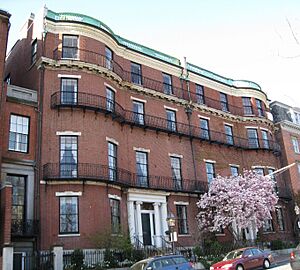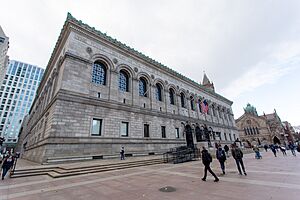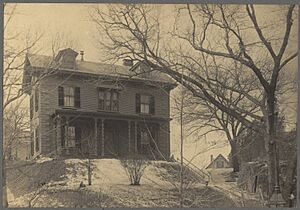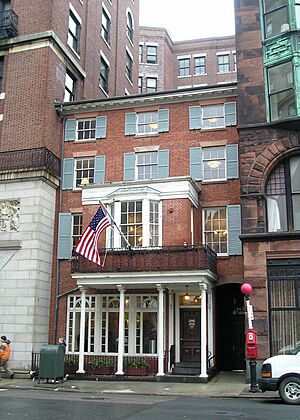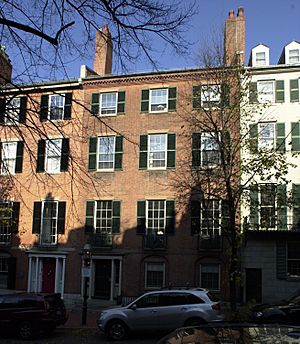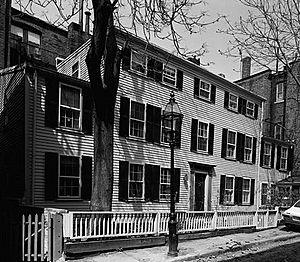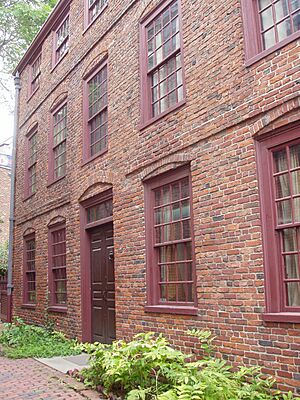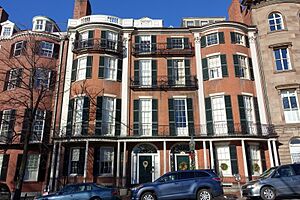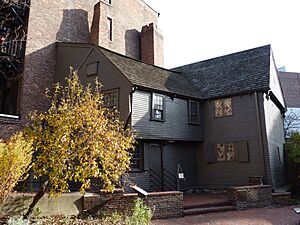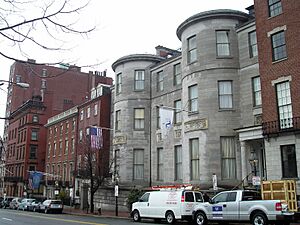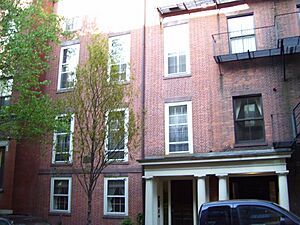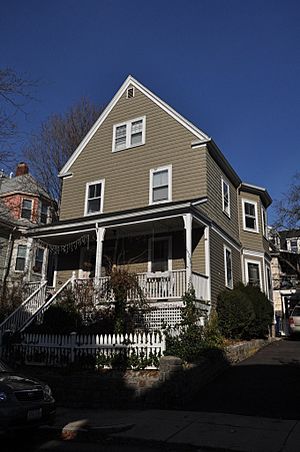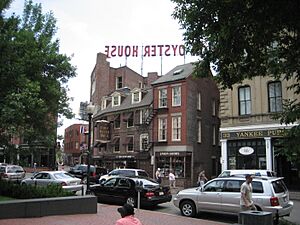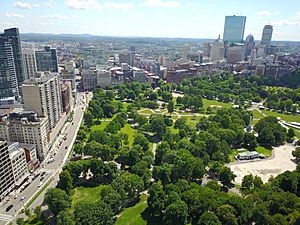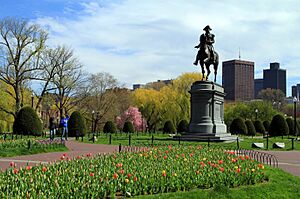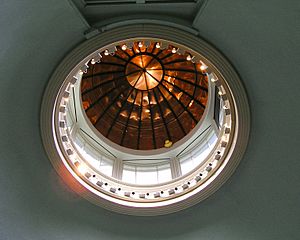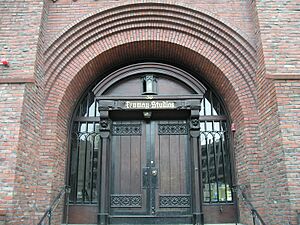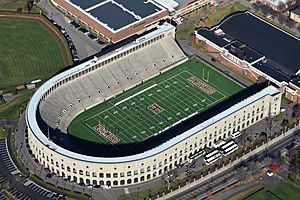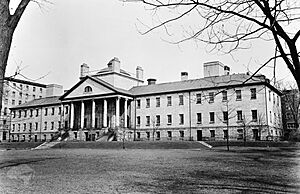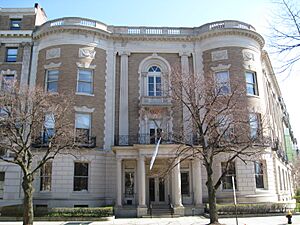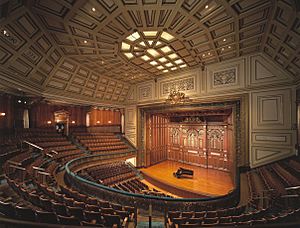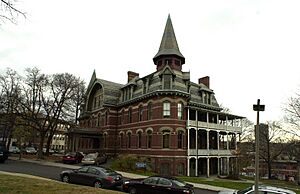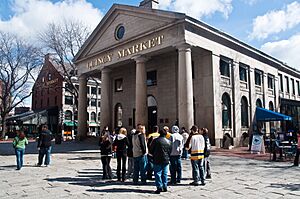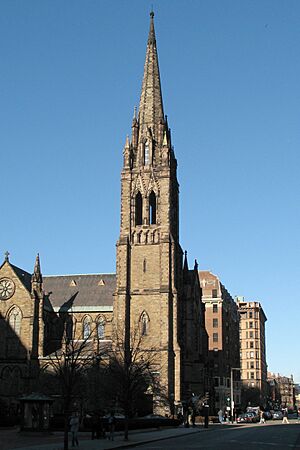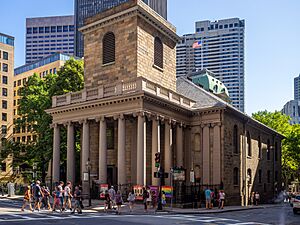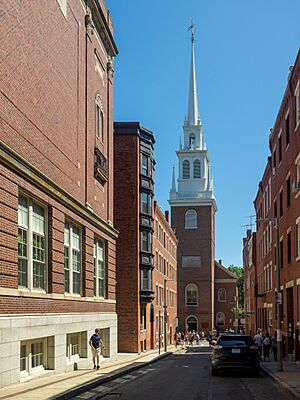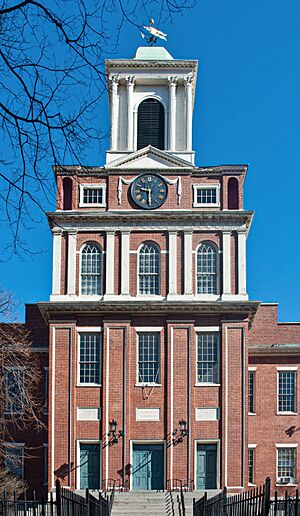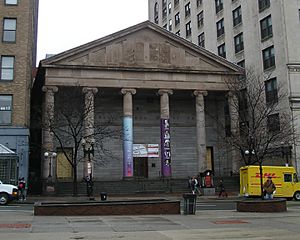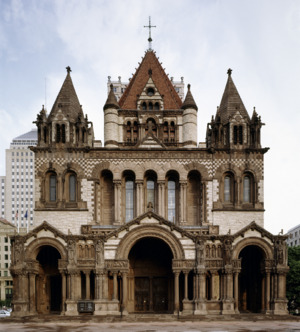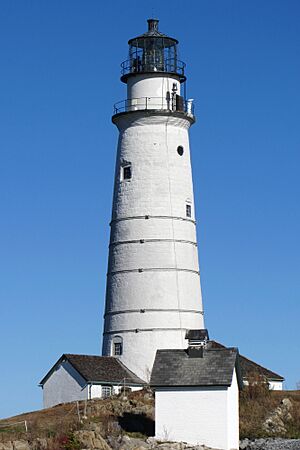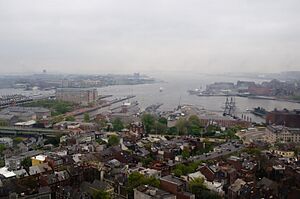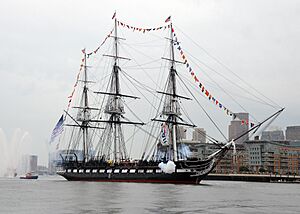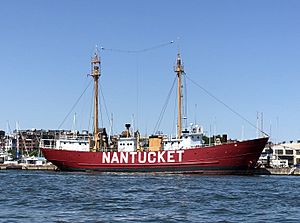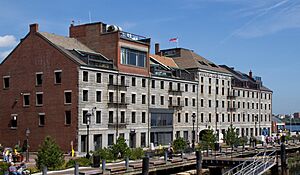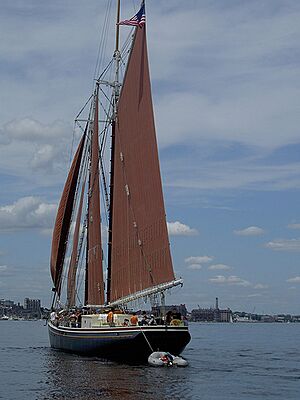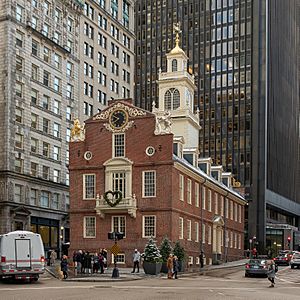List of National Historic Landmarks in Boston facts for kids
Boston, Massachusetts, is a city full of history! It's home to many special places called National Historic Landmarks. These are buildings, sites, or objects that are super important to the history of the United States. Boston has 57 of these amazing landmarks, which is more than any other big city in the country. This means there's a lot of history packed into Boston!
Contents
Exploring Boston's Historic Landmarks
Boston's National Historic Landmarks are found all over the city, from the busy waterfront to the quiet neighborhoods like Jamaica Plain. Each one tells a unique story about America's past.
Historic Buildings and Homes
Many landmarks in Boston are old buildings and houses where important events happened or famous people lived.
- African Meeting House: Built in 1806, this building is the oldest Black church still standing in the U.S. It was a vital place for the Black community and the fight against slavery.
- Nathan Appleton Residence: This was the home of Nathan Appleton, a businessman who helped grow the textile industry. His daughter, Fanny, married the famous poet Henry Wadsworth Longfellow here.
- Frederick Ayer Mansion: This mansion is special because its inside was designed by Louis Comfort Tiffany, a famous artist. It also has a rare outdoor mosaic by Tiffany.
- Boston Athenaeum: This building houses one of the oldest and largest private libraries in the country. It's a beautiful place for reading and learning.
- Boston Public Library, McKim Building: Built in the 1880s, this grand library was inspired by European libraries. It has amazing murals by John Singer Sargent and a huge, bright reading room called Bates Hall.
- First Harrison Gray Otis House: This house was built for Harrison Gray Otis, an important political leader. It was designed by the famous architect Charles Bulfinch.
- William Lloyd Garrison House: This was the home of William Lloyd Garrison, a key leader in the movement to end slavery. He published an anti-slavery newspaper called The Liberator from here.
- Gibson House Museum: This Victorian house is unique because it still has its original design, both inside and out. It became a museum in 1957.
- Chester Harding House: This Federal-style home belonged to Chester Harding, a well-known portrait artist.
- Samuel Gridley and Julia Ward Howe House: This house was home to Julia Ward Howe, who wrote "The Battle Hymn of the Republic," and her husband, Samuel Gridley Howe, both strong supporters of ending slavery. It was designed by Charles Bulfinch.
- William C. Nell House: This was the home of William Cooper Nell, an important abolitionist and advocate for education.
- Francis Parkman House: This house was the home of Francis Parkman, a famous historian and gardener.
- Pierce–Hichborn House: Built around 1711, this is a rare old brick house. It's right next to the Paul Revere House.
- William H. Prescott House: Also known as Headquarters House, this 1808 house was designed by Asher Benjamin and was home to the famous blind historian William H. Prescott.
- Paul Revere House: This is the oldest house still standing in Boston, built in 1680. It was the home of Paul Revere, a hero of the American Revolution. Today, it's a museum on Boston's Freedom Trail.
- Ellen Swallow Richards House: This was the home of Ellen Swallow Richards, the first woman to graduate from the Massachusetts Institute of Technology and the first woman to get an advanced degree in chemistry.
- David Sears House: This grand townhouse from 1816 was owned by David Sears, a Boston developer and politician. It has a beautiful front made of carved granite.
- Shirley–Eustis House: Built in the 1740s, this Georgian house was home to two Massachusetts governors: William Shirley and William Eustis.
- Charles Sumner House: This Federal-style townhouse from around 1806 was the home of Charles Sumner, a U.S. Senator and a strong voice against slavery.
- William Monroe Trotter House: This house was home to William Monroe Trotter, an African-American journalist and Harvard graduate. Important meetings of Black activists, including W. E. B. Du Bois, took place here.
- Union Oyster House: Opened in 1826, this is the oldest restaurant in the United States that's still operating! The building itself is even older, from the early 1700s.
Important Public Spaces and Institutions
Boston also has landmarks that are public spaces, hospitals, and cultural centers.
- Arnold Arboretum: This beautiful arboretum (a place where many different trees and plants are grown) is owned by Harvard University. It was designed in 1872 by Frederick Law Olmsted, a famous landscape architect.
- Beacon Hill Historic District: This historic neighborhood is famous for its beautiful architecture, including buildings designed by Charles Bulfinch. Many famous people, including politicians and business leaders, have lived here.
- Boston Common: Established in 1634, the Common is the oldest public park in the United States. It's a beloved green space in the heart of the city.
- Boston Public Garden: This was the first public botanical garden in the country. It was designed in the 1860s in a beautiful French style.
- Ether Dome, Massachusetts General Hospital: This was the operating room of the Massachusetts General Hospital from 1821 to 1867. It's where the first public demonstration of using ether as an anesthetic (to make people feel no pain during surgery) happened.
- Fenway Studios: This building was specially built in 1904–1905 to be studios for artists, in the Arts and Crafts style.
- Harvard Stadium: Built in 1903, this stadium was a model for many other stadiums. At the time, it was the largest building made from reinforced concrete.
- Massachusetts General Hospital, Bulfinch Building: This is the original building for the Massachusetts General Hospital, one of the first public hospitals in the nation. It was designed by Charles Bulfinch and includes the famous Ether Dome.
- Massachusetts Historical Society Building: This building, built in 1899, is home to the Massachusetts Historical Society, which was founded in 1791 and is the oldest historical society in the U.S.
- Massachusetts Statehouse: This is the state's capitol building, where the government meets. It was built in the 1790s by Charles Bulfinch. Its famous dome was originally covered in copper by Paul Revere and is now covered in gold leaf.
- New England Conservatory of Music (Jordan Hall): The conservatory's 1903 building includes Jordan Hall, a performance space known for its amazing sound quality.
- New England Hospital for Women and Children (Dimock Community Health Center Complex): Opened in 1872, this was the first public hospital in New England run by women doctors. It's now called the Dimock Center.
- Old City Hall (Boston): This building was one of the first in the U.S. designed in the Second Empire style. It served as Boston's city hall from 1865 to 1969.
- Quincy Market: Built in the 1820s, this market was designed by Alexander Parris. It's a very popular place for tourists today.
- Symphony Hall, Boston: This hall has been the home of the Boston Symphony Orchestra since it was built in 1900. It's famous for its excellent acoustics, meaning the sound is incredible inside.
- Tremont Street Subway: This is the oldest subway tunnel in North America! It started running in 1897 and is still used today.
Churches and Meeting Houses
Several churches and meeting houses in Boston are also National Historic Landmarks, important for their history and architecture.
- Central Congregational Church (Church of the Covenant): This church has the largest complete Tiffany-designed interior in its original location in America.
- King's Chapel: This church was built on the site of Boston's first Anglican (Church of England) church. Today, it's home to a Unitarian Universalist group.
- Old North Church: Built in 1723, this is the oldest active church building in Boston. It's famous for being where Paul Revere had lanterns hung ("one if by land, two if by sea") to warn about British troop movements before the Battles of Lexington and Concord.
- Old South Church in Boston: Built in 1873, this church is home to one of Boston's oldest groups of worshipers, started in 1670.
- Old South Meeting House: This building from 1729 was where the Boston Tea Party was planned on December 16, 1773. It was also a place for many other important public meetings during the American Revolution.
- Old West Church (Boston, Massachusetts): This church, built in 1806, stands on the site of an earlier church known for its opposition to British rule. A famous preacher here, Jonathan Mayhew, might have even created the phrase "no taxation without representation".
- Cathedral Church of St. Paul, Boston: This Greek Revival church was built in 1819. It was the first Episcopal church built in Boston after America became independent.
- Trinity Church, Boston: Built in the 1870s, this church is a great example of the Richardsonian Romanesque style of architecture. It's considered one of the "Ten Most Significant Buildings in the United States" by the American Institute of Architects.
Historic Ships and Waterfront Sites
Boston's history is also tied to the sea, with several maritime landmarks.
- Boston Light: This is the second oldest lighthouse still standing in the U.S. It's on Little Brewster Island in Boston Harbor. It's also the only lighthouse that is always staffed by the United States Coast Guard.
- Boston Naval Shipyard: This is one of the oldest shipyards in the U.S. It's home to two other National Historic Landmark ships: the USS Constitution and the USS Cassin Young. It also has the only surviving "ropewalk" (a long building where ropes were made) that hasn't been moved or changed much.
- USS Cassin Young (DD-793): This was a Fletcher|destroyer ship launched during Second World War. It fought in important battles like the Battle of Leyte and the Battle of Okinawa.
- USS Constitution: This ship is the world's oldest floating warship that is still officially in service! Launched in 1797, it fought in the War of 1812. Today, it's a museum ship.
- Lightship No. 112, "Nantucket": This was the largest lightship (a ship that acts like a lighthouse) ever built. It was also the last active lightship when it was named a landmark.
- Long Wharf and Custom House Block: This wharf was built in the early 1700s and was one of the busiest trading spots in Great Britain's North American colonies for many years.
- Roseway (Schooner): Launched in 1925, this wooden sailing ship was mainly used for racing.
Revolutionary War Sites
Several landmarks are important for their connection to the American Revolution.
- Bunker Hill Monument: This monument was built in the mid-1800s on Breed's Hill. This is where most of the fighting happened during the 1775 Battle of Bunker Hill.
- Faneuil Hall: This famous market building and meeting house was built in the 1760s. Many public meetings took place here during the American Revolution.
- Fort Warren: This 19th-century fort was built in Boston Harbor. It was used through the First World War and is named after Dr. Joseph Warren, a Revolutionary War leader who died at the Battle of Bunker Hill.
- Old State House: Built in 1712, this building was where the Massachusetts colonial and state government met until 1793. The Boston Massacre happened right outside this building on March 5, 1770.
National Park Service Historic Areas in Boston
Besides the National Historic Landmarks, some other important historic places are managed by the National Park Service. These sites are already highly protected and are very important to the nation's history.
- Boston African American National Historic Site: This site includes 15 locations, with the African Meeting House and the Abiel Smith School being two of them. These sites are connected by the Black Heritage Trail and tell the story of Boston's African American community.
- Boston National Historical Park: This park includes eight sites around Boston, many of which are part of the famous Freedom Trail.
See also



